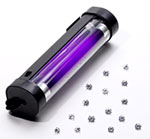 Diamond fluorescence is a form of illumination that is created when a diamond is exposed to Ultraviolet (UV) light. Your diamond can be exposed to UL light from the “back-lights” often found in nightclubs, the drying lights used in nail salons, fluorescent lights or direct sunlight. Diamonds emit light due to fluorescence when small amounts of the element boron are present in the stone. Blue is the most common color of fluorescence, but other colors (yellow, greenish blue, green, white and pink) are also possible.
Diamond fluorescence is a form of illumination that is created when a diamond is exposed to Ultraviolet (UV) light. Your diamond can be exposed to UL light from the “back-lights” often found in nightclubs, the drying lights used in nail salons, fluorescent lights or direct sunlight. Diamonds emit light due to fluorescence when small amounts of the element boron are present in the stone. Blue is the most common color of fluorescence, but other colors (yellow, greenish blue, green, white and pink) are also possible.
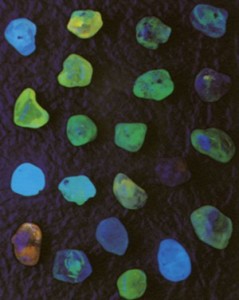
About 35% of gem quality diamonds have fluorescence that can be seen under an ultraviolet light. About 10% of gem quality diamonds have enough fluorescence to make a noticeable difference in the diamond’s color when viewed under incandescent light (low in UL) and in sunlight or fluorescent light (high in UL). In less than 2% of diamonds, the level of fluorescence is high enough to cause the diamond to appear foggy or milky in appearance.
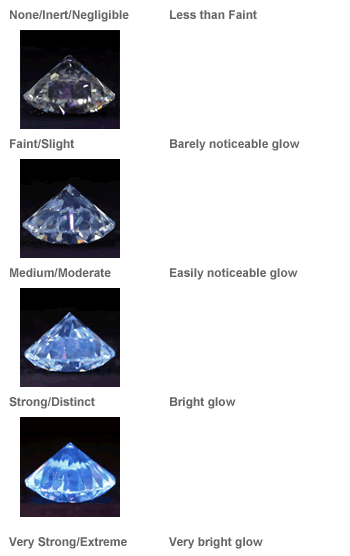
Grading laboratories use various grades to categorize ranges of fluorescence intensity as viewed with a UV light source. These grades align themselves roughly as follows:
Impact on Diamond Value
There is ongoing debate as to what the impact of fluorescence has on the beauty or value of a diamond. Years ago, fluorescence was considered a real positive because some thought it improved the color and appearance of diamonds, especially those with faint yellow body color.
 Before grading reports, there was a widespread preference for diamonds with fluorescence and they often sold at a premium to diamonds without fluorescence. This was due to the fact that colorless diamonds with strong blue fluorescence look similar to the very rare diamonds that actually have blue body color. The term “blue-white” became a status symbol and referred to colorless (D, E and F) diamonds with strong blue fluorescence. The Federal Trade Commission established a rule that limited the use of the term “blue-white” to only include diamonds with blue fluorescence. This was an effort to keep consumers from being mislead and thinking it meant blue body color. The term is seldom used today because jewelers do not want to bring attention to fluorescence.
Before grading reports, there was a widespread preference for diamonds with fluorescence and they often sold at a premium to diamonds without fluorescence. This was due to the fact that colorless diamonds with strong blue fluorescence look similar to the very rare diamonds that actually have blue body color. The term “blue-white” became a status symbol and referred to colorless (D, E and F) diamonds with strong blue fluorescence. The Federal Trade Commission established a rule that limited the use of the term “blue-white” to only include diamonds with blue fluorescence. This was an effort to keep consumers from being mislead and thinking it meant blue body color. The term is seldom used today because jewelers do not want to bring attention to fluorescence.
The public’s perception of fluorescence seemed to change when grading reports started listing fluorescence ratings. It was used originally in diamond certifications as additional information for identification, but eventually it began to affect the value of the diamonds. Diamond shoppers wanted to avoid anything “extra” in their diamonds whether it was color, inclusions or fluorescence.
The following table illustrates the potential impact of fluorescence on the price of diamonds and how that can vary for various combinations of color, clarity and fluorescence grades.
| Color | Fluorescence | IF-VVS | VS | SI-I3 |
| D E | Very Strong | -10% to -15% | -6% to -10% | 0 to -3% |
| Strong | -7% to -10% | -3% to -5% | 0 to -1% | |
| Medium | -3% to -7% | -1% to 2% | 0 | |
| Fain | 0 | 0 | 0 | |
| F G H | Very Strong | -7% to -10% | -3% to -5% | 0 |
| Strong | -5% to -7% | -2% to -3% | 0 | |
| Medium | -1% to -3% | 0 to -2% | 0 | |
| Faint | 0 | 0 | 0 | |
| I J K | Very Strong | 0 to 3% | 0 to 3% | 0 to 3% |
| Strong | 0 to 2% | 0 to 2% | 0 to 3% | |
| Medium | 0 to 2% | 0 to 2% | 0 to 2% | |
| Faint | 0 | 0 | 0 |
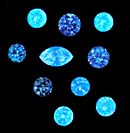 When inflation was high in the 1980’s diamonds with high color and clarity became attractive investments for some speculators. However, when they went to sell their diamonds, they discovered that high fluorescence greatly reduced the amount they could get for their diamonds. This was widely publicized and diamond shoppers ever since have been avoiding fluorescence.
When inflation was high in the 1980’s diamonds with high color and clarity became attractive investments for some speculators. However, when they went to sell their diamonds, they discovered that high fluorescence greatly reduced the amount they could get for their diamonds. This was widely publicized and diamond shoppers ever since have been avoiding fluorescence.
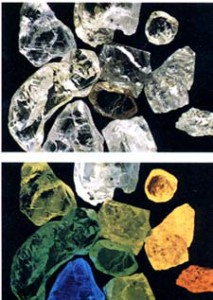
The GIA Gem Trade Laboratory recently conducted an experiment to assess the effects of UL radiation on the color appearance and transparency of gem diamonds. The results of the study seemed to support the historical perception that UV fluorescence generally has a positive effect on the overall appearance of a diamond. The perception that fluorescence aids the appearance of color is only valid for blue emissions. When the fluorescence is yellow in nature, it tends to detract from the color and lower the value of diamonds.
Whether fluorescence has a negative or positive impact on appearance seems to have little impact on today’s diamond shopper’s perceptions. They tend to want to avoid fluorescence and certainly to not want to pay a premium for diamonds with any fluorescence.
Advice: For diamonds in the near colorless range (G, H, I and J), faint fluorescence should be considered a neutral or even a slight positive as it can improve the appearance of the diamond. For J or K color diamonds, medium fluorescence can often be warranted to accommodate a bigger diamond for the same dollars. For colorless (D, E and F) diamonds, we recommend no fluorescence unless a diamond with exceptional cut and size for the price can be obtained with Faint fluorescence.
Diamond Industry Perceptions
Historically, the diamond industry has given names to certain types of fluorescence diamonds based on the mines that produced large amounts of these fluorescent stones.
- Premier is a term used to describe light yellow diamonds with strong blue fluorescence because such diamonds were often sourced from South Africa’s Premier mine.
- Jager is a term used to describe colorless diamonds with strong blue fluorescence because these stones were common from the Jagersfontein mine in South Africa.
In the early years of the diamond industry, merchants would seek near-colorless to light yellow diamonds with strong blue fluorescence because the stones were perceived to appear “more colorless.” Often these diamonds were marketed as “blue-white,” a term that was prohibited by the U.S. Federal Trade Commission in 1938.
Diamonds with fluorescence can have different color appearance when viewed under lights with different levels of ultraviolet content. In the early 1940’s, the diamond industry and in particular, the GIA grading laboratory, realized the importance of controlling the lighting conditions for consistent color grading. This has provided some consistency in color grading, regardless of the level of fluorescence.
During the early 1970’s, investors purchased “investment quality” diamonds (high color and high clarity diamonds) as a hedge against rampant inflation. At the time, little was known about cut or fluorescence so many of the diamonds sold had poor cut and strong fluorescence. At the end of the 1970’s these investors started selling their diamonds only to find the received substantially lower prices for stones termed “milky D’s” which were diamonds with D color grade, very strong blue fluorescence, and reduced transparency. In the decades that followed, the perceived negative impact of fluorescence extended down the color grade scale and down the fluorescence intensity scale. Today, many diamond shoppers purchasing even I color diamonds have a tendency to avoid even Faint levels of fluorescence. It makes no difference that they can not see a difference, just the fact that the certification says it has fluorescence has become a negative factor for many.
Right or wrong, the consumer has perceived concerns about fluorescence stemming from several notions:
- Anything “extra” in a diamond must mean the diamond with fluorescence is not as “pure” as a diamond without fluorescence.
- Since the perception is that there are fewer colorless (D-E-F) diamonds without fluorescence than those with fluorescence, the non-fluorescent diamonds are considered rarer.
- Consumer’s perceive that if some diamonds with strong fluorescence have a milky appearance, then diamonds with medium or faint fluorescence might have some reduced level of transparency too.
- Diamond shoppers who rely almost totally on the certification values for making a purchase decision, find the fluorescence grades (Faint, Medium, Strong, Very Strong) easy to understand and tend to avoid these, thus increasing the perceived value of diamonds with a fluorescence rating of None.
The GIA released the results of a study in 1997 that addressed the effect of blue fluorescence on the appearance of diamonds. Here are some of the conclusions of that study:
- In general, the level of fluorescence had no widely perceptible effect on the color appearance of diamonds viewed table down (upside down).
- In the table up position, diamonds described as Strong or Very Strong fluorescence appeared to have better color than less fluorescence stones.
- The effect of fluorescence on color was most noticeable in the lower (I-J-K) colors.
- Non-trade observers in the test had more difficulty than those in the diamond trade in seeing meaningful distinctions of fluorescence on color appearance or transparency.
